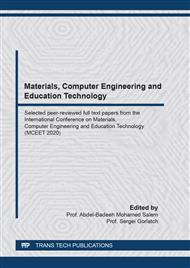[1]
M. García-Carmona, A. Romero-Freire, M. Sierra Aragón, et al, Evaluation of Remediation Techniques in Soils Affected by Residual Contamination with Heavy Metals and Arsenic, Journal of Environmental Management. 191 (2017) 228-236.
DOI: 10.1016/j.jenvman.2016.12.041
Google Scholar
[2]
A.G.F. Boim, L.C.A. Melo, F.N. Moreno, et al, Bioconcentration factors and the risk concentrations of potentially toxic elements in garden soils, Journal of Environmental Management. 170(2016) 21-27.
DOI: 10.1016/j.jenvman.2016.01.006
Google Scholar
[3]
Q.L. Yang, Z.Y. Li, X.N. Lu, et al, A Review of Soil Heavy Metal Pollution from Industrial and Agricultural Regions in China: Pollution and Risk Assessment, The Science of the Total Environment. 642(2018) 690-700.
DOI: 10.1016/j.scitotenv.2018.06.068
Google Scholar
[4]
X.L. Jia, B.F. Hu, B. Marchant, et al, A Methodological Framework for Identifying Potential Sources of Soil Heavy Metal Pollution Based on Machine Learning: A Case Study in the Yangtze Delta, China. Environmental Pollution. 250(2019) 601-609.
DOI: 10.1016/j.envpol.2019.04.047
Google Scholar
[5]
Z.H. Pan, K.Y. Wang, L. Wang, et al, Risk Assessment System Based on WebGIS for Heavy Metal Pollution in Farmland Soils in China, Sustainability (Basel, Switzerland). 9(2017) 1846.
DOI: 10.3390/su9101846
Google Scholar
[6]
H.F. Wang, Q.M. Wu, W.Y. Hu, et al, Using Multi-medium Factors Analysis to Assess Heavy Metal Health Risks along the Yangtze River in Nanjing, Southeast China. Environmental Pollution. 243(2018) 1047-1056.
DOI: 10.1016/j.envpol.2018.09.036
Google Scholar
[7]
V. Rackwitz, M. Ostermann, U. Panne, et al, Performance of μ-XRF with SEM/EDS for Trace Analysis on the Example of RoHS Relevant Elements-Measurement, Optimisation and Prediction of the Detection Limits, JAAS (Journal of Analytical Atomic Spectrometry). 28(2013) 1466-1475.
DOI: 10.1039/c3ja50064k
Google Scholar
[8]
S. Ershadi, A. Shayanfar, Are LOD and LOQ Reliable Parameters for Sensitivity Evaluation of Spectroscopic Methods?, Journal of AOAC International. 101(2018) 1212-1213.
DOI: 10.5740/jaoacint.17-0363
Google Scholar
[9]
C. Mcgladdery, D.C. Weindorf, S. Chakraborty, et al, Elemental assessment of vegetation via portable X-ray fluorescence (PXRF) spectrometry. Journal of Environmental Management. 210(2018) 210-225.
DOI: 10.1016/j.jenvman.2018.01.003
Google Scholar
[10]
S. Carter, A.S. Fisher, M.W. Hinds, et al, Atomic spectrometry update. Review of advances in the analysis of metals, chemicals and materials. Journal of Analytical Atomic Spectrometry. 28(2013) 1814-1869.
DOI: 10.1039/c3ja90051g
Google Scholar
[11]
K. Nakano, N. Chihiro, O. Kazunori, et al, Depth Elemental Imaging of Forensic Samples by Confocal Micro-XRF Method, Analytical Chemistry. 83(2011) 3477-3483.
DOI: 10.1021/ac1033177
Google Scholar
[12]
L. Herreros-Chavez, M.L. Cervera, and A. Morales-Rubio, Direct Determination by Portable ED-XRF of Mineral Profile in Cocoa Powder Samples, Food Chemistry. 278(2013) 373-379.
DOI: 10.1016/j.foodchem.2018.11.065
Google Scholar
[13]
X.P. Wang, F. Zhang, J.L. Ding, et al, Estimation of soil salt content (SSC) in the Ebinur Lake Wetland National Nature Reserve (ELWNNR), Northwest China, based on a Bootstrap-BP neural network model and optimal spectral indices. The Science of the total environment. 615(2018) 918-930.
DOI: 10.1016/j.scitotenv.2017.10.025
Google Scholar
[14]
N. Loris, B. Sheryl, L. Alessandra, Double committee adaboost. Journal of King Saud- University-Science. 25(2013) 29-37.
Google Scholar
[15]
S. Al‐Shidhani, N.U. Rehman, F. Mabood, et al, Quantification of Incensole in Three Boswellia Species by NIR Spectroscopy Coupled with PLSR and Cross‐Validation by HPLC, Phytochemical Analysis. 29(2018) 300-307.
DOI: 10.1002/pca.2743
Google Scholar
[16]
G. Guven, H. Samkar, Examination of Dimension Reduction Performances of PLSR and PCR Techniques in Data with Multicollinearity. Iranian Journal of Science and Technology, Transactions A: Science. 43(2019) 969-978.
DOI: 10.1007/s40995-018-0565-1
Google Scholar
[17]
W.D. Li, X. Yang, H. Li, et al, Hybrid Forecasting Approach Based on GRNN Neural Network and SVR Machine for Electricity Demand Forecasting, Energies. 10(2017) 44.
DOI: 10.3390/en10010044
Google Scholar
[18]
C. Zhen, K. Dohyeon, K. Hee-joung, Brain image segmentation based on improved BP-adaboost neural network. Society of Photo-Optical Instrumentation Engineers(SPIE). 111050(2019) 110500Q–110500Q-7.
Google Scholar


